UIA-HYP CUP 2021 International Student Competition in Architectural Design

UIA-HYP CUP 2021 International Student Competition in Architectural Design now is over!
UIA-HYP CUP 2021 International Student Competition in Architectural Design, an annual architectural competition organized by the School of Architecture Tianjin University and Urban Environment Design (UED) Magazine has been recently opened for entries inviting all architecture and relevant major students around the globe to participate.
Short description
UIA-HYP Cup International Student Competition in Architectural Design, an annual architectural competition organized by the School of Architecture, Tianjin University and Urban Environment Design (UED) Magazine now is calling for enties!
The theme is 'Architecture in Transformation'. Architecture in Transformation should respond to contemporary challenges and changes. What concerns us primarily is the relationship between architecture and city, as well as the one between architecture and natural environment. The competition aims at searching and constructing human space with a Spirit of Place in the increasingly fragmented cities and unordered villages, exploring environment-friendly and sustainable ideas in the information age, and integrating creative concepts with solid basic skills in architectural design.
COUNTRYSIDE DILLEMAS - NEW RURAL PLANNING
The advent of the year of the Ox brought destruction to the ancient village of Wongding in Yunnan, which has been recognized as important cultural countryside heritage since 2006. The fire that raged through Wongding however exposed more fundamental dilemmas that go beyond replacing the village’s thatched rooftops and intricate wood constructions, which my team and I have been observed in many places in the world for some time now. It coincides with an important crossroads in thinking about the future of the countryside in Chin and beyond.
China’s rural development has been largely based on top-down industrial planning. Like in many places in the world this brought modernity to the countryside and offered dramatic improvements in the quality of life for many. It however also meant that historical, natural, and cultural quality concentrated in age-old ways of living suffered. In 2020 the unprecedented anti-poverty campaigns in China that reshaped countrysides since the 1970s across the nation and specifically areas not unlike those we find in and around Wongding came to a first completion. This important milestone marks an important moment for reflection on this initial way of working not only for China: it demands new considerations on the future of planning the countryside.
China is not alone in this struggle. In the exhibition and book Countryside. The Future I showed with the AMO team and a large group of experts how far architecture has drifted from the countryside across the globe. From looming environmental disaster in Russia, the firm corporate grip of ruthless forms of Cartesianism in the West, to the larger global consequences of preservation and growing migration crises, we show that thinking and planning the countryside has never been more important for a shared future.
The old way of planning large swaths of countryside around the world was largely based on an industrial and material-based planning method or the narrow interests of markets. Both are up for reinvention. We also witness how conventional ways of defining heritage are buckling under pressure of packaged tourism, generating a hollowing of what we consider authentic. Combined with the new ambitious sustainability and rural revitalization goals, these are new milestones of a different nature, which need a new approach in it recognizing the quality of village life. Both the environment and the need for more sustainable ways of living urge us to rethink our relationships with nature and culture. It is also clear that a new generation wants a different form of interaction with the countryside. Informal tools and platforms like Chinese Rural Taobao, rural social media platforms like Kwaisho, and small-scaled technological and financial add-ons used in the Sub-Sahara, offer the start of a new toolkit for planning, framing, and experiencing the countryside: offering hybrid active lifestyles where countryside and urban activity generate a new blended life. Besides convenience and comfort, the authenticity of a ‘real’experience and focus is paramount.
The countryside fundamentally challenges the paradigm of the architectural profession by requiring a more deeply ingrained role compared to being a city’s ‘service provider’. There might be no such thing as architecture related-information to fall back to. Rural context requires a skills set where economy, infrastructure, new and old technology, and culture have to work in unison, in order to generate new experiences. Solely mastering old arts and crafts will not bring the future that is needed.
Organiser ask you to submit these ideas and/or the best case studies examples that challenge existing planning tradition to collectively build a library of the most relevant and interesting possibilities to give a new fundamentally revised view of the future of the countryside.
The competition requires the participants to make detailed insights and reflections on architectural development, explore complicated demands of the people nowadays for architecture and environment, pay attention to specific sites and the events happening in them, and configure viable and dynamic urban and architectural spaces, at the same time seek suitable techniques to guarantee the possibility of implementation of the project.
The winners will decide by the jury panel selected from among the world's most outstanding architects and deans from schools of architecture.
Note! The registration deadline is September 20th, 2021, but you can submit your project until October 10th, 2021.
Submission requirements:
➜ Projects should propose new experimental planning formats and proposals in the countryside. These proposals are not limited to China and invite all countrysides across the globe.
➜ The plans should show engagement with and involvement of local communities with a social, economic, and new cultural component. Ideally you work directly with locals.
➜ Projects should make use of new (digital) infrastructures in a novel way, not as a gimmick and have a relationship with popular (contemporary countryside) culture.
➜ Projects should strongly consider their own economic and ecological sustainability and address this.
➜ Format for presentation is a movie no longer than 2:00 minutes and three A1 boards. The movie and boards have a free format. Make your projects stick out, striking, fresh, exciting and engaging.
➜ The movie is not allowed to show personally identifiable information
➜ Plans, sections, elevations and renderings can be used when relevant.
➜ Your submission has to be subtitled in English.
Who may enter?
This competition is open to all architecture and relevant major students around the globe.
Prize:
➜ 1st Prize (1 team) - Certificate and 100,000 RMB (approx.15, 000 USD)
➜ 2nd Prize (3 teams) - Certificate and 30,000 RMB (approx.4, 500 USD)
➜ 3rd Prize (8 teams) - Certificate and 10,000 RMB (approx. 1, 500 USD)
➜ Honorable Mentions (several teams) - Honor Certificate
Entry fees:
The registration fee for the domestic group is 200 RMB per group.





